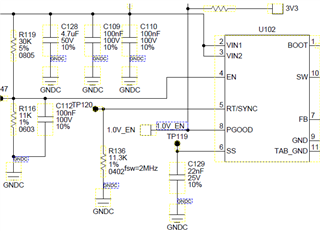Other Parts Discussed in Thread: LMR14030-Q1, , LMR14030
Hi,
It's mentioned" For design with LMR14030-Q1 in WSON package, the maximum value of CSS is 4.7 nF." in datasheet.
WSON package is used in our application, EN pin is connected to external circuit, not to VIN. What will be happened if Css is 22nF? How can I design the test case to verify/simulate it?
If we change EN connection like below way, is it OK to keep Css 22nF?

In order to understand the mechanism of Soft start, I find serial related questions had been answered before. Sorry still unclear about some points. It's much appreciated to have your opinion.
1. I am not clear about" If you ramp too slowly, the device will go into current limit trying to charge the output caps. " which mentioned in below link. Could you please kindly explain more?
2. A waveform is posted about no soft start at begining, however, I don't know The mean of channel 1, 2, 4. Could you please give your comments. I assume channel 4 is output current, The peak current means no Soft start, the correct one should be like Datasheet "Figure 24 Start-up By Vin IL waveform", right?
3. I don't undstand why Css will be no discharge path if Vin powered and EN disabled, would you please kindly share your comments?
Plus, Same desription of LMR14030 WSON package in datasheet. May I know whehter same behavior between LMR14030-Q1 and LMR14020-Q1?
Do you have any PSpice simulation file of LMR14020-Q1?
Thanks!


